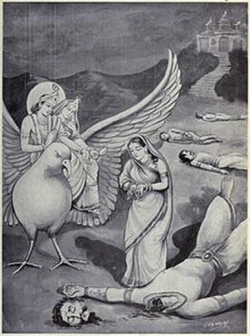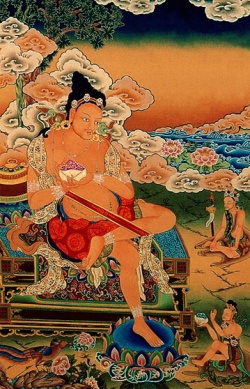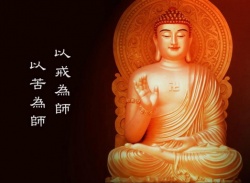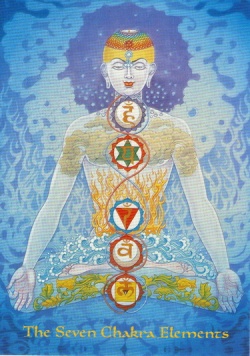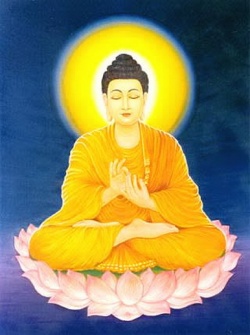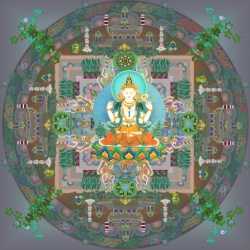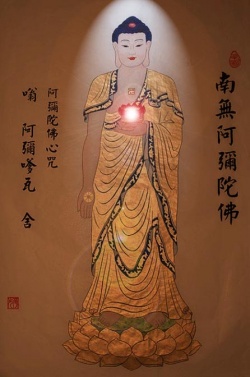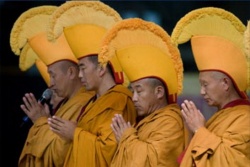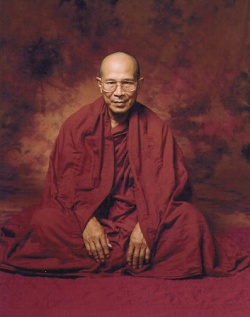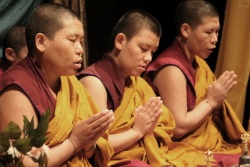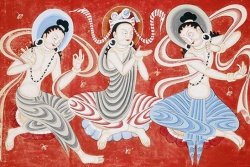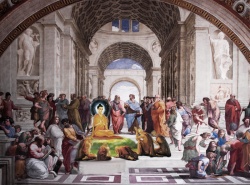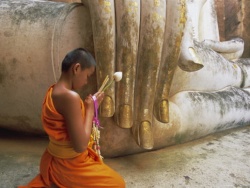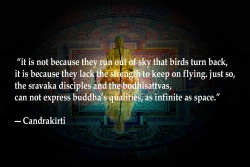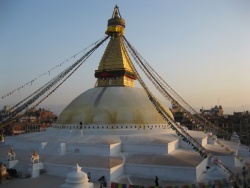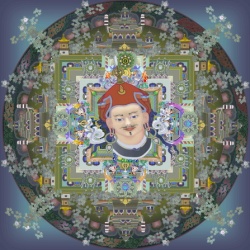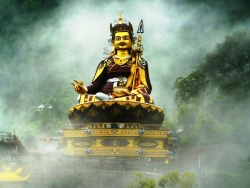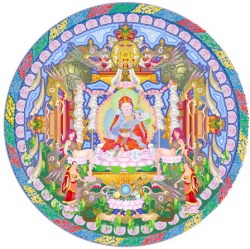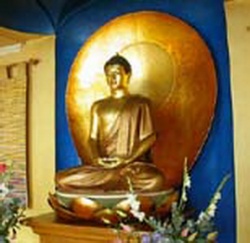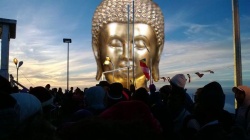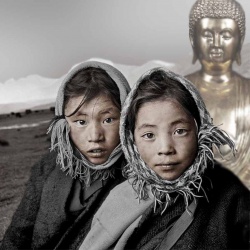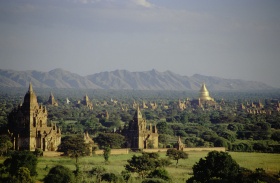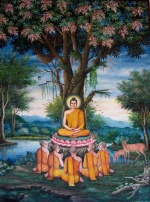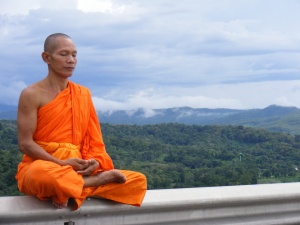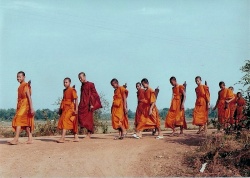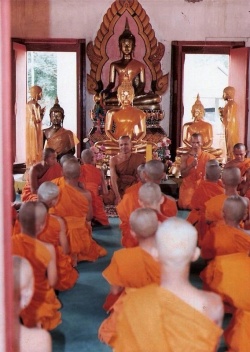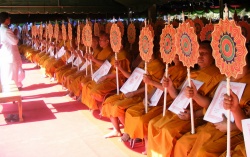Theravāda
Theravada, Sanskrit: स्थविरवाद sthaviravāda is literally "the Teaching of the Elders." The name comes from the ancestral Sthaviravada, from which the Theravadins claim descent. After unsuccessfully trying to modify the Vinaya, a small group of 'elderly members' i.e. sthaviras broke away from the majority during the Second Buddhist council, giving rise to the Sthaviravada.
Unlike Mahayanists, Theravadins follow crypto-realist Abhidharma.
The term Theravāda Buddhism refers, first, to a "school" and closely related "orientations" within the history of Buddhist monasticism and, second, to forms of Buddhist religious, political, and social life in various Buddhist countries.
Although these two aspects of Theravāda Buddhism must be distinguished, they overlap and interact in various ways at different points in Theravāda history.
In the present article, the specifically monastic aspects will receive priority, but reference will be made to the civilizational dimension as well.
For many centuries, it has been the predominant religion of Sri Lanka (now about 70% of the population) and most of continental Southeast Asia (Cambodia, Laos, Myanmar, Thailand).
Theravada is also practiced by minorities in parts of southwest China (mainly by the Shan and Tai ethnic groups), Vietnam (by the Khmer Krom), Bangladesh (by the ethnic groups of Baruas, Chakma, Magh, and Tanchangya), Malaysia and Indonesia, while recently gaining popularity in Singapore and the Western world.
Today, Theravada Buddhists, otherwise known as Theravadins, number over 150 million worldwide, and during the past few decades Theravada Buddhism has begun to take root in the West[a] and in the Buddhist revival in India.
History
Indian origins

According to its own accounts, the Theravāda school is fundamentally derived from the Vibhajjavāda (or "doctrine of analysis") grouping which was a division of the Sthavira ("Elders") stream. The Sthavira were in turn a breakaway group from the majority Mahāsāṃghika during the Second Buddhist council.
Theravadin accounts of its own origins mention that it received the teachings that were agreed upon the Third Buddhist Council, around 250 BCE, and these teachings were known as the Vibhajjavada. The Vibhajjavādins in turn split into four groups: the Mahīśāsaka, Kāśyapīya, Dharmaguptaka, and the Tāmraparnīya.
Sri Lanka
The Theravada is descended from the Tāmraparnīya, which means "the Sri Lankan lineage." In the 7th century CE, Chinese pilgrims Xuanzang and Yijing refer to the Buddhist schools in Sri Lanka as Shàngzuòbù (Ch. 上座部), corresponding to the Sanskrit "Sthavira" and the Pali "Thera." The school has been using the name Theravada for itself in a written form since at least the 4th century, when the term appears in the Dipavamsa.
Transmission to Sri Lanka
According to Buddhist scholar A.K. Warder, the Theravada
... spread rapidly south from Avanti into Maharastra and Andhra and down to the Chola country (Kanchi), as well as Ceylon. For some time they maintained themselves in Avanti as well as in their new territories, but gradually they tended to regroup themselves in the south, the Great Vihara (Mahavihara) in Anuradhapura, the capital of Ceylon, becoming the main centre of their tradition, Kanchi a secondary center and the northern regions apparently relinquished to other schools.
According to the Pāli chronicles of the Sinhalese tradition, Buddhism was first brought to Sri Lanka by Arahant Mahinda, who is believed to have been the son of the Mauryan emperor Asoka, in the third century BCE, as a part of the dhammaduta (missionary) activities of the Asokan era. In Sri Lanka, Arahant Mahinda established the Mahāvihāra Monastery of Anuradhapura.
Subdivisions
Over much of the early history of Buddhism in Sri Lanka, three subdivisions of Theravāda existed in Sri Lanka, consisting of the monks of the Mahāvihāra, Abhayagiri Vihāra, and the Jetavana Vihāra. Mahāvihāra is the first tradition to be established, while Abhayagiri Vihāra and Jetavana Vihāra is established by monks who have broke away from Mahāvihāra tradition. According to A.K. Warder, the Indian Mahīśāsaka sect also established itself in Sri Lanka alongside the Theravāda, into which they were later absorbed. Northern regions of Sri Lanka also seem to have been ceded to sects from India at certain times.

When the Chinese monk Faxian visited the island in the early 5th century CE, he noted 5000 monks at Abhayagiri, 3000 monks at the Mahāvihāra, and 2000 monks at the Cetiyapabbatavihāra.
Mahayana-influences
Over the centuries, the Abhayagiri Theravādins maintained close relations with Indian Buddhists and adopted many new teachings from India. including many elements from Mahāyāna teachings, while the Jetavana Theravādins adopted Mahāyāna to a lesser extent.
Xuanzang wrote of two major divisions of Theravāda in Sri Lanka, referring to the Abhayagiri tradition as the "Mahāyāna Sthaviras," and the Mahāvihāra tradition as the "Hīnayāna Sthaviras."
Akira Hirakawa notes that the surviving Pāli commentaries (Aṭṭhakathā) of the Mahāvihāra school, when examined closely, also include a number of positions that agree with Mahāyāna teachings. Kalupahana notes the same for the Visuddhimagga, the most important Theravada commentary.
In the 8th century CE, it is known that both Mahāyāna and the esoteric Vajrayāna form of Buddhism were being practiced in Sri Lanka, and two Indian monks responsible for propagating Esoteric Buddhism in China, Vajrabodhi and Amoghavajra, visited the island during this time. Abhayagiri Vihāra appears to have been a center for Theravadin Mahāyāna and Vajrayāna teachings.
Abolition of other Theravāda traditions
Some scholars have held that the rulers of Sri Lanka ensured that Theravāda remained traditional, and that this characteristic contrasts with Indian Buddhism. However, before the 12th century CE, more rulers of Sri Lanka gave support and patronage to the Abhayagiri Theravādins, and travelers such as Faxian saw the Abhayagiri Theravādins as the main Buddhist tradition in Sri Lanka.
The trend of Abhayagiri Vihara being the dominant Theravāda sect changed in the 12th century CE, when the Mahāvihāra gained the political support of King Parakkamabāhu I (1153-1186 CE), and completely abolished the Abhayagiri and Jetavana Theravāda traditions. The Theravāda monks of these two traditions were then defrocked and given the choice of either returning to the laity permanently, or attempting re-ordination under the Mahāvihāra tradition as "novices" (sāmaṇera).
Regarding the differences between these three Theravāda traditions, the Cūḷavaṁsa laments, "Despite the vast efforts made in every way by former kings down to the present day, the Bhikkhus turned away in their demeanor from one another and took delight in all kinds of strife."
Lineage of nuns
A few years after the arrival of Sthavira Mahinda, Bhikkhuni Sanghamitta, who is also believed to be the daughter of Emperor Asoka, came to Sri Lanka. She started the first nun's order in Sri Lanka, but this order of nuns died out in Sri Lanka in the 11th century and in Burma in the 13th. In 429 CE, by request of China's emperor, nuns from Anuradhapura were sent to China to establish the Nun's Order.
The order was then spread to Korea. In 1996, 11 selected Sri Lankan nuns were ordained fully as Bhikkhunis by a team of Theravāda monks in concert with a team of Korean Nuns in India.
There is disagreement among Theravada vinaya authorities as to whether such ordinations are valid. In the last few years the head of the Dambulla chapter of the Siyam Nikaya in Sri Lanka has carried out ordination ceremonies for hundreds of nuns.
This has been criticized by other leading figures in the Siyam Nikaya and Amarapura Nikaya, and the governing council of Burmese Buddhism has declared that there can be no valid ordination of nuns in modern times, though some Burmese monks disagree with this.
Southeast Asia
According to Mahavamsa the Sri Lanka chronicle, after the conclusion of the Third Buddhist Council, a missionary was also sent to Suvannabhumi where two monks Sona and Uttara, are said to have proceeded. Scholar opinions differ as to where exactly this land of Suvannabhumi is located, but Suvannabhumi is believed to be located somewhere in the area which now includes lower Burma, Thailand, Malay Peninsula and Sumatra Island.
Before the 12th century, the areas of Thailand, Burma, Laos, and Cambodia were dominated by various Buddhist sects from India, and included the teachings of Mahāyāna Buddhism. In the 7th century, Yijing noted in his travels that in these areas, all major sects of Indian Buddhism flourished.
Burma
Though there are some early accounts that have been interpreted as Theravāda in Burma, the surviving records show that most Burmese Buddhism incorporated Mahāyāna, and used Sanskrit rather than Pali. After the decline of Buddhism in India, missions of monks from Sri Lanka gradually converted Burmese Buddhism to Theravāda, and in the next two centuries also brought Theravāda Buddhism to the areas of Thailand, Laos, and Cambodia, where it supplanted previous forms of Buddhism.
The Mon and Pyu were among the earliest people to inhabit Burma. Recent archaeological research at a Pyu settlement in the Samon Valley (around 100 km south-east of Bagan) has shown that they had trade links with India from 500-400 BC and with China around 200 BC.
Chinese sources which have been dated to around 240 A.D. mention a Buddhist kingdom by the name of Lin-Yang, which some scholars have identified as the ancient Pyu kingdom of Beikthano 300 km north of Yangon.
The oldest surviving Buddhist texts in the Pali language come from Pyu city of Sri Ksetra, the text which is dated from the mid 5th A.D. to mid 6th A.D. is written on twenty-leaf manuscript of solid gold. The Burmese slowly became Theravadan when they came into contact with the Pyu and Mon civilization. The Thais also slowly became Theravadan as they came into contact with the Mon civilization.
China
Despite its success in Southeast Asia, Theravada Buddhism in China has generally been limited to areas bordering Theravada countries.
Modernisation and spread to the west
See also: Buddhist modernism and Vipassana movement
In the 19th century began a process of mutual influence of both Asian Theravadins and a western audience interested in ancient wisdom. Especially Helena Blavatsky and Henry Steel Olcott, founders of the Theosophical Society had a profound role in this process. In Theravada countries developed a lay vipassana practice. From the 1970s on western interest gave way to the growth of the so-called Vipassana movement in the west
Reaction against western colonialism
Buddhist revivalism has also reacted against changes in Buddhism caused by colonialist regimes. Western colonialists and Christian missionaries deliberately imposed a particular type of Christian monasticism on Buddhist clergy in Sri Lanka and colonies in Southeast Asia, restricting monks' activities to individual purification and temple ministries.
Prior to British colonial control, monks in both Sri Lanka and Burma had been responsible for the education of the children of lay people, and had produced large bodies of literature. After the British takeover, Buddhist temples were strictly administered and were only permitted to use their funds on strictly religious activities. Christian ministers were given control of the education system and their pay became state funding for missions.
Foreign, especially British, rule had an enervating effect on the sangha. According to Walpola Rahula, Christian missionaries displaced and appropriated the educational, social, and welfare activities of the monks, and inculcated a permanent shift in views regarding the proper position of monks in society through their institutional influence upon the elite.
Many monks in post-colonial times have been dedicated to undoing this paradigm shift. Movements intending to restore Buddhism's place in society have developed in both Sri Lanka and Burma.
One of the results of the reactions against western colonialism was the modernisation of Theravada Buddhism, incorporating western elements, and opening meditation practice for a lay audience. It are those modernized forms of Theravada practice which have been spread to the west.
Sri Lanka
See also: Buddhism in Sri Lanka
At Sri Lanka Theravadins were looking at western culture to find means to revitalize their own tradition. Christian missionaries were threatening the indigenous culture.
As a reaction, Theravadins started to propagate Theravada Buddhism. They were aided by Theosophists, who were looking for ancient wisdom, and expected this to be found, among other possible sources, within Buddhism and the Pali canon.
Anagarika Dharmapala was one of the Tharavada leaders with whom the Theosophists sided. Dharmapala tried to reinstate vipassana, taking the visudhimagga and the Pali canon to find out a workable method. Dharmapala reached out to the middle classes, offering them religious practice and a religious identity, which were used to withstand the British imperialists.
A practical consequence was a change in the religious configuration of the island, with lay practitioners practicing meditation, which before was reserved for monks.
The translation and publication of the Pali canon by the Pali Text Society, which for the first time in history made the pali canon available to a lay audience, not only in the west, but also in the east. Western lay interest in Theravada Buddhism was promoted by the Theosophical Society, and endured until the beginning of the 20th century. During the 1970s interest rose again, leading to a surge of westerners searching for enlightenment, and the republishing of the Pali canon, first in print, and later also at the web.
Thailand

See also: Buddhism in Thailandand Thai Forest Tradition
With the coming to power in 1851 of King Mongkut, who had been a monk himself for twenty-seven years, the sangha, like the kingdom, became steadily more centralized and hierarchical, and its links to the state more institutionalized. Mongkut was a distinguished scholar of Pali Buddhist scripture. Moreover, at that time the immigration of numbers of monks from Burma was introducing the more rigorous discipline characteristic of the Mon sangha. Influenced by the Mon and guided by his own understanding of the Tipitaka, Mongkut began a reform movement that later became the basis for the Dhammayuttika order of monks.
In the early 1900s, Thailand's Ajahn Sao Kantasilo Mahathera and his student, Mun Bhuridatta led the Thai Forest Tradition revival movement. In the 20th century notable practitioners included Ajahn Thate, Ajahn Maha Bua and Ajahn Chah. It was later spread globally by Ajahn Mun's students including Ajahn Thate, Ajahn Maha Bua and Ajahn Chah and several western disciples, among whom the most senior is Luang Por Ajahn Sumedho.
Burma
See also: Buddhism in Burma
Birmese Theravada Buddhism has had a profound influence on modern vipassana practice, both for lay practitioners in Asia as lay practitioners in the west.
The so-called "New Burmese method" was developed by U Nārada and popularized by his students Mahasi Sayadaw and Nyanaponika Thera. Another prominent teacher is Bikkhu Bodhi, a student of Nyanaponika.
The New Burmese Method strongly emphasizes vipassana over samatha. It is regarded as a simplification of traditional Buddhist meditation techniques, suitable not only for monks but also for lay-practitioners. The method has been popularized in the west by teachers as Joseph Goldstein, Jack Kornfield, Tara Brach, Gil Fronsdal and Sharon Salzberg.
The Ledi lineage begins with Ledi Sayadaw. S.N. Goenka is a well-known teacher in the Ledi-lineage. According to S. N. Goenka, vipassana-techniques are essentially non-sectarian in character, and have universal application. One need not convert to Buddhism to practice these styles of meditation.
Meditation centers teaching the vipassanā popularized by S. N. Goenka exist now in India, Asia, North and South America, Europe, Australia, Middle East and Africa.
Modern developments
The following modern trends or movements have been identified.
- Modernism: attempts to adapt to the modern world and adopt some of its ideas; including, among other things
- Green movement
- Syncretism with other Buddhist traditions
- Universal inclusivity
- Reformism: attempts to restore a supposed earlier, ideal state of Buddhism; includes in particular the adoption of Western scholars' theories of original Buddhism (in recent times the "Western scholarly interpretation of Buddhism" is the official Buddhism prevailing in Sri Lanka and Thailand.)
- Ultimatism: tendency to concentrate on advanced teachings such as the Four Noble Truths at the expense of more elementary ones
- Neotraditionalism; includes among other things
- Revival of ritualism
- Remythologization
- Insight meditation
- Social action
- Devotional religiosity
- Reaction to Buddhist nationalism
- Renewal of forest monks
- Revival of samatha meditation
- Revival of the Theravada bhikkhuni lineage (not recognized in Thailand)
Doctrinal differences with other schools
See also: Early Buddhism, Pre-sectarian Buddhism, Early Buddhist schools
The Sthaviravada, from which Theravada is derived, differed from other early Buddhist schools on a variety of teachings, which are maintained by the Theravada school. The differences resulted from the systematizion of the Buddhist teachings, which was preserved in the Abdhidhammas of the various schools.
The Abhidhamma is "a restatement of the doctrine of the Buddha in strictly formalized language [...] assumed to constitute a consistent system of philosophy". It's aim is not the empirical verification of the Buddhist teachings, but "to set forth the correct interpretation of the Buddha's statements in the Sutra to restate his 'system' with perfect accuracy".
The Arahant is perfect
The Mahāsāṃghika believed that Arahants could regress, while the Theravada believes that the Arahant has an "incorruptible nature"
Insight is sudden and perfect
According to the Sthaviravada/Theravada, "progress in understanding comes all at once, 'insight' (abhisamaya) does not come 'gradually' (successively - anapurva)". This is reflected in the Theravada-account on the four levels of attainment, in which the attainment of the four paths appears suddenly, and the defilements are rooted out at once. The same stance is taken in the contemporary Vipassana movement, especially the so-called "New Burmese Method".
Dharmas
The commentaries gave a new definition of "a 'principle' or 'element' (dharma)":
Dharmas are what have (or 'hold', 'maintain', dhr is the nearest equivalent in the language to the English 'have') their own own-being (svabhava). It is added that they naturally (yathasvabhavatas) have this through conditions (pratyaya). The idea is that they are distinct, definable, principles in the constitution of the universe."
Teachings
Theravada promotes the concept of Vibhajjavada (Pali), literally "Teaching of Analysis." This doctrine says that insight must come from the aspirant's experience, critical investigation, and reasoning instead of by blind faith. However, the scriptures of the Theravadin tradition also emphasize heeding the advice of the wise, considering such advice and evaluation of one's own experiences to be the two tests by which practices should be judged.
Theravada orthodoxy takes the seven stages of purification as its basic outline of the path to be followed.
The Theravada Path starts with learning, to be followed by practice, culminating in the realization of Nirvana.
Learning
The Three Characteristics
See also: Three marks of existence
Throughout the Pail-canon two characteristics of all conditioned phenomena and one characteristic of all dhammas are being mentioned. The Theravada tradition has grouped them together. Insight into these three characteristics is the entry to the Buddhist path:
- Anicca (impermanence): All conditioned phenomena are subject to change, including physical characteristics, qualities, assumptions, theories, knowledge, etc. Nothing is permanent, because, for something to be permanent, there has to be an unchanging cause behind it. Since all causes are recursively bound together, there can be no ultimate unchanging cause.
- Dukkha (suffering): Craving causes suffering, since what is craved is transitory, changing, and perishing. The craving for impermanent things causes disappointment and sorrow.
There is a tendency to label practically everything in the world, as either "good," "comfortable" or "satisfying;" or "bad", "uncomfortable," and "unsatisfying." Labeling things in terms of like and dislike creates suffering.
If one succeeds in giving up the tendency to label things and free himself from the instincts that drive him towards attaining what he himself labels collectively as "liking," he attains the ultimate freedom. The problem, the cause, the solution and the implementation, all of these are within oneself, not outside.
- Anatta (not-self): all dhammas lack a fixed, unchanging 'essence'; there is no permanent, essential Self.
A living being is a composite of the five aggregates (khandhas), which is the physical forms (rupa), feelings or sensations (vedana), perception (sanna), mental formations (sankhara), and consciousness (vinnana), none of which can be identified as one's Self.
From the moment of conception, all entities (including all living beings) are subject to a process of continuous change. A practitioner should, on the other hand, develop and refine his or her mind to a state so as to see through this phenomenon.
Truly understanding this counter-intuitive concept of Buddhism requires direct and personal experience. This is given in vipassana-practice.closely watching the continuous changes in the Five Aggregates,
Dukkha - The Four Noble Truths
See also: Four Noble Truths
The Four Noble Truths are described as follows:
- Dukkha (suffering): This can be somewhat broadly classified into three categories. Inherent suffering, or the suffering one undergoes in all the worldly activities, what one suffers in day-to-day life: birth, aging, diseases, death, sadness, etc.
In short, all that one feels from separating from "loving" attachments and/or associating with "hating" attachments is encompassed into the term.
The second class of suffering, called Suffering due to Change, implies that things suffer due to attaching themselves to a momentary state which is held to be "good"; when that state is changed, things are subjected to suffering.
The third, termed Sankhara Dukkha, is the most subtle.
Beings suffer simply by not realizing that they are mere aggregates with no definite, unchanging identity.
- Dukkha Samudaya (cause of suffering): Craving, which leads to Attachment and Bondage, is the cause of suffering.
Formally, this is termed Tanha. It can be classified into three instinctive drives.
Kama Tanha is the Craving for any pleasurable sense object (which involves sight, sound, touch, taste, smell and mental perceptives).
Bhava Tanha is the Craving for attachment to an ongoing process, which appears in various forms, including the longing for existence. Vibhava Tanha is the Craving for detachment from a process, which includes non-existence and causes the longing for self-annihilation.
- Dukkha Nirodha (cessation of suffering): One cannot possibly adjust the whole world to one's taste in order to eliminate suffering and hope that it will remain so forever.
This would violate the chief principle of Change. Instead, one adjusts one's own mind through detachment so that the Change, of whatever nature, has no effect on one's peace of mind. Briefly stated, the third Noble Truth implies that elimination of the cause (craving) eliminates the result (suffering).
This is inferred in the scriptural quote by The Buddha, 'Whatever may result from a cause, shall be eliminated by the elimination of the cause'.
- Dukkha Nirodha Gamini Patipada (pathway to freedom from suffering):
This is the Noble Eightfold Pathway towards freedom or Nirvana. The path can roughly be rendered into English as right view, right intention, right speech, right actions, right livelihood, right effort, right mindfulness and right concentration.
Defilements
See also: Kleshas
In Theravada, the cause of human existence and suffering (dukkha) is identified as craving (tanha), which carries with it the defilements (kilesas). Those defilements that bind humans to the cycle of rebirth are classified into a set of ten "Fetters," while those defilements that impede concentration (samadhi) are presented in a fivefold set called the "Five Hindrances."
The level of defilement can be coarse, medium, and subtle. It is a phenomenon that frequently arises, remains temporarily and then vanishes. Theravadins believe defilements are not only harmful to oneself, but also harmful to others. They are the driving force behind all inhumanities a human being can commit.
There are three stages of defilements. During the stage of passivity the defilements lie dormant at the base of the mental continuum as latent tendencies (anusaya), but through the impact of sensory stimulus, they will manifest (pariyutthana) themselves at the surface of consciousness in the form of unwholesome thoughts, emotions, and volitions.
If they gather additional strength, the defilements will reach the dangerous stage of transgression (vitikkama), which will then involve physical or vocal actions.
Ignorance
See also: Avijja
Theravadins believe these defilements are habits born out of ignorance that afflict the minds of all unenlightened beings, who cling to them and their influence in their ignorance of the truth. But in reality, those mental defilements are nothing more than taints that have afflicted the mind, creating suffering and stress.
Unenlightened beings cling to the body, under the assumption that it represents a Self, whereas in reality the body is an impermanent phenomenon formed from the four basic elements. Often characterized by earth, water, fire and air, in the early Buddhist texts these are defined to be abstractions representing the sensorial qualities solidity, fluidity, temperature, and mobility, respectively.
The mental defilements' frequent instigation and manipulation of the mind is believed to have prevented the mind from seeing the true nature of reality. Unskillful behavior in turn can strengthen the defilements, but following the Noble Eightfold Path can weaken or eradicate them. Avijja is destroyed by insight.
Cause and Effect
See also: Pratītyasamutpāda
The Concept of Cause and Effect, or Causality, is a key concept in Theravada, and indeed, in Buddhism as a whole. This concept is expressed in several ways, including the Four Noble Truths, and most importantly, the Paticca-Samuppāda (dependent co-arising).
Abhidhamma in Theravada canon differentiate between a root cause (Hetu) and facilitating cause (pacca). By the combined interaction of both these, an effect is brought about. On top of this view, a logic is built and elaborated whose most supple form can be seen in the Paticca Samuppāda.
This concept is then used to question the nature of suffering and to elucidate the way out of it, as expressed in the Four Noble Truths. It is also employed in several suttas to refute several philosophies including creationism.
By taking away a cause, the result will also disappear. From this follows the Buddhist path to end suffering and existence in samsara.
Practice
Theravada orthodoxy takes the seven stages of purification as the basic outline of the path to be followed. This basic outline is based on the threefold discipline of Sīla (ethics or discipline), Samādhi (meditative concentration), Pañña (understanding or wisdom). The emphasis is on understanding the three marks of existence, which removes vijnana, ignorance. Understanding destroys the Ten Fetters and leads to Nirvana.
Theravadins believe that every individual is personally responsible for their own self-awakening and liberation, as they are the ones that were responsible for their own actions and consequences (Sanskrit: karma; Pali: kamma). Simply learning or believing in the true nature of reality as expounded by the Buddha is not enough, the awakening can only be achieved through direct experience and personal realization. Yet there is a widespread believe in Theravada that we're living in a degenerated epoch, in which true liberation is no longer possible.
Noble Eightfold Path and Threefold Discipline
See also: Noble Eightfold Path
In the Sutta Pitaka the path to liberation is described by the Noble Eightfold Path:
The Blessed One said, "Now what, monks, is the Noble Eightfold Path? Right view, right resolve, right speech, right action, right livelihood, right effort, right mindfulness, right concentration.
The Noble Eightfold Path can also be summarized as the Three Noble Disciplines. These are known as discipline (sīla), wisdom (paññā), and training of mind (samādhi).
Seven purification's
The Visuddhimagga, written in the fifth century CE by Buddhaghosa, has become the orthodox account of the Theravda path to liberation. It gives a sequence of seven purifications, based on the sequence of sila, samadhi and prajna.
It is composed of three sections, which discuss: 1) Sīla (ethics or discipline); 2) Samādhi (meditative concentration); 3) Pañña (understanding or wisdom).
- The first section (part 1) explains the rules of discipline, and the method for finding a correct temple to practice, or how to meet a good teacher.
- The second section (part 2) describes samatha's practice, object by object (see Kammatthana for the list of the forty traditional objects). It mentions different stages of concentration.
- The third section (part 3-7) is a description of the five skandhas (aggregates), ayatanas, the Four Noble Truths, dependent origination (Pratitya-samutpada), and the practice of vipassana through the development of wisdom. It emphasizes different forms of knowledge emerging because of the practice. This part shows a great analytical effort specific to Buddhist philosophy.
The seven purification's are:
- Purification of Conduct (sīla-visuddhi)
- Purification of Mind (citta-visuddhi)
- Purification of View (ditthi-visuddhi)
- Purification by Overcoming Doubt (kankha-vitarana-visuddhi)
- Purification by Knowledge and Vision of What Is Path and Not Path (maggamagga-ñanadassana-visuddhi)
- Purification by Knowledge and Vision of the Course of Practice (patipada-ñanadassana-visuddhi)
- Knowledge of contemplation of rise and fall (udayabbayanupassana-nana)
- Knowledge of contemplation of dissolution (bhanganupassana-nana)
- Knowledge of appearance as terror (bhayatupatthana-nana)
- Knowledge of contemplation of danger (adinavanupassana-nana)
- Knowledge of contemplation of dispassion (nibbidanupassana-nana)
- Knowledge of desire for deliverance (muncitukamyata-nana)
- Knowledge of contemplation of reflection (patisankhanupassana-nana)
- Knowledge of equanimity about formations (sankharupekka-nana)
- Conformity knowledge (anuloma-nana)
- Purification by Knowledge and Vision (ñanadassana-visuddhi)
The "Purification by Knowledge and Vision" is the culmination of the practice, in four stages leading to liberation and Nirvana.
The emphasis in this system is on understanding the three marks of existence, dukkha, anatta, anicca. This emphasis is recognizable in the value that is given to vipassana over samatha, especially in the contemporary vipassana movement.
Meditation
See also: Buddhist meditation
Theravada Buddhist meditation practices fall into two broad categories: samatha, and vipassanā. This distinction is not made in the suttas, but in the Visuddhimagga. Some common terms encountered in the Theravada practice of meditation are:
Meditation (Pali: Bhavana) means the positive reinforcement of one's mind. Broadly categorized into Samatha and Vipassana, Meditation is the key tool implemented in attaining jhana. Samatha literally means "to make skillful," and has other renderings also, among which are "tranquilizing, calming," "visualizing," and "achieving." Vipassana means "insight" or "abstract understanding." In this context, Samatha Meditation makes a person skillful in concentration of mind. Once the mind is sufficiently concentrated, Vipassana allows one to see through the veil of ignorance.
In order to be free from suffering and stress, Theravadins believe that the defilements need to be permanently uprooted. Initially the defilements are restrained through mindfulness to prevent them from taking over mental and bodily action.
They are then uprooted through internal investigation, analysis, experience and understanding of their true nature by using jhana. This process needs to be repeated for each and every defilement. The practice will then lead the meditator to realize Nirvana.
Samatha meditation
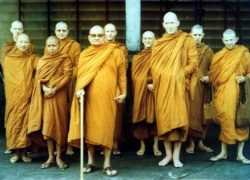
See also: Samatha
The samatha meditation in Theravada is usually involved with the concepts of Kammaṭṭhāna which literally stands for "place of work"; in this context, it is the "place" or object of concentration (Pāli: Ārammana) where the mind is at work. In samatha meditation, the mind is set at work concentrated on one particular entity. There are forty such classic objects (entities) used in samatha meditation, which are termed Kammaṭṭhāna. By acquiring a Kammaṭṭhāna and practising samatha meditation, one would be able to attain certain elevated states of awareness and skill of the mind called Jhana. Practising samatha has samadhi (concentration) as its ultimate goal.
It should be noted that samatha is not a method that is unique to Buddhism. In the suttas it is said to be implemented in other contemporary religions in India at the time of Buddha. In fact, the first teachers of Siddhartha, before they attained the state of awakening (Pāli: Bodhi), are said to have been quite skillful in samatha (although the term had not been coined yet).
In the Pali Canon discourses, the Buddha frequently instructs his disciples to practice samadhi (concentration) in order to establish and develop jhana (full concentration). Jhana is the instrument used by the Buddha himself to penetrate the true nature of phenomena (through investigation and direct experience) and to reach Enlightenment. Right Concentration (samma-samadhi) is one of the elements in the Noble Eightfold Path.
Samadhi can be developed from mindfulness developed with kammaṭṭhāna such as concentration on breathing (anapanasati), from visual objects (kasina), and repetition of phrases. The traditional list contains 40 objects of meditation (kammaṭṭhāna) to be used for Samatha Meditation.
Every object has a specific goal; for example, meditation on the parts of the body (kayanupassana or kayagathasathi) will result in a lessening of attachment to our own bodies and those of others, resulting in a reduction of sensual desires. Mettā (loving kindness) generates the feelings of goodwill and happiness toward ourselves and other beings; metta practice serves as an antidote to ill-will, wrath and fear.
Vipassanā meditation
See also: Vipassanā
Vipassanā is the ability to see everything as is. "Vi" in pali means great or beyond, while "passanā" means to see. Vipassanā then is concerned with seeing through the veil of ignorance (Pāli: Avijjā) and so, is unique to Buddhism. It can be aided by a practised mind (with samatha) but samatha is not necessary to practice vipassanā. Chiefly, vipassanā is involved in breaking the ten Fetters that bind one to the ever-iterating cycle of birth and death i.e. samsara. Some teachers do not distinguish between the two methods, rather prescribing meditation methods that develop both concentration and insight.
Attainment
Path and fruit
Practice leads to mundane and supramundane wisdom, leading to Nirvana:
The term "supramundane" [[[lokuttara]]] applies exclusively to that which transcends the world, that is the nine supramundane states: Nibbana, the four noble paths (magga) leading to Nibbana, and their corresponding fruits (phala) which experience the bliss of Nibbana.
Mundane wisdom is the insight in the three marks of existence. The development of this insight leads to four supramundane paths and fruits:
Each path is a momentary peak experience directly apprehending Nibbana and permanently cutting off certain defilements.
Each path is followed by its supramundane fruit:
whereas the path performs the active function of cutting off defilements, fruition simply enjoys the bliss and peace that result when the path has completed its task. Also, where the path is limited to a single moment of consciousness, the fruition that follows immediately on the path endures for two or three moments. And while each of the four paths occurs only once and can never be repeated, fruition remains accessible to the noble disciple.
Levels of attainment
See also: Four stages of enlightenment
Four levels of supramundane wisdom can be attained:
- Stream-Enterers: Those who have destroyed the first three fetters (false view of Self, doubt, and clinging to rites and rituals);
- Once-Returners: Those who have destroyed the first three fetters and have lessened the fetters of lust and hatred;
- Non-Returners: Those who have destroyed the five lower fetters, which bind beings to the world of the senses;
- Arahants: Those who have reached Enlightenment—realized Nirvana, and have reached the quality of deathlessness—are free from all the fermentations of defilement. Their ignorance, craving and attachments have ended.
Nirvana
Nirvana (Sanskrit: निर्वाण, Nirvāṇa; Pali: निब्बान, Nibbāna; Thai: นิพพาน, Nípphaan) is the ultimate goal of Theravadins. It is a state where the fire of the passions has been 'blown out', and the person is liberated from the repeated cycle of birth, illness, aging and death.
According to the early scriptures, the Nirvana attained by Arahants is identical to that attained by the Buddha himself, as there is only one type of Nirvana. Buddha was superior to Arahants because the Buddha had discovered the path all by himself, and has taught it to others (i,e., metaphorically turning the wheel of Dhamma).
Arahants, on the other hand, attained Nirvana due in part to the Buddha's teachings. Theravadins revere the Buddha as a single supremely gifted person but do recognize the existence of other such Buddhas in the distant past and future. Maitreya (Pali: Metteyya), for example, is mentioned very briefly in the Pali Canon as a Buddha who will come in the distant future.
Scriptures

Pali Canon
See also: Pali Canon
The Theravada school upholds the Pali Canon or Tipitaka as the most authoritative collection of texts on the teachings of Gautama Buddha. The Sutta and Vinaya portion of the Tipitaka shows considerable overlap in content to the Agamas, the parallel collections used by non-Theravada schools in India which are preserved in Chinese and partially in Sanskrit, Prakrit, and Tibetan, and the various non-Theravada Vinayas. On this basis, both these sets of texts are generally believed to be the oldest and most authoritative texts on Buddhism by scholars.
It is also believed that much of the Pali Canon, which is still used by Theravāda communities, was transmitted to Sri Lanka during the reign of Asoka. After being orally transmitted (as was the custom in those days for religious texts) for some centuries, were finally committed to writing in the last century BC, at what the Theravada usually reckons as the fourth council, in Sri Lanka. Theravada is one of the first Buddhist schools to commit the whole complete set of its Buddhist canon into writing.
Much of the material in the Canon is not specifically "Theravadan," but is instead the collection of teachings that this school preserved from the early, non-sectarian body of teachings. According to Peter Harvey:
The Theravadans, then, may have added texts to the Canon for some time, but they do not appear to have tampered with what they already had from an earlier period.
The Pali Tipitaka consists of three parts: the Vinaya Pitaka, Sutta Pitaka and Abhidhamma Pitaka. Of these, the Abhidhamma Pitaka is believed to be a later addition to the first two pitakas, which, in the opinion of many scholars, were the only two pitakas at the time of the First Buddhist Council. The Pali Abhidhamma was not recognized outside the Theravada school.
The Tipitaka is composed of 45 volumes in the Thai edition, 40 in the Burmese and 58 in the Sinhalese, and a full set of the Tipitaka is usually kept in its own (medium-sized) cupboard.
Commentaries
In the 4th or 5th century Buddhaghosa Thera wrote the first Pali commentaries to much of the Tipitaka (which were based on much older manuscripts, mostly in old Sinhalese). After him many other monks wrote various commentaries, which have become part of the Theravada heritage. These texts do not have the same authority as the Tipitaka does, though Buddhaghosas Visudhimaggha is a cornerstone of the commentarial tradition.
The commentaries, together with the Abhidhamma, define the specific Theravada heritage. Related versions of the Sutta Pitaka and Vinaya Pitaka were common to all the early Buddhist schools, and therefore do not define only Theravada, but also the other early Buddhist schools, and perhaps the teaching of Gautama Buddha himself.
Theravada Buddhists consider much of what is found in the Chinese and Tibetan Mahayana scriptural collections to be apocryphal, meaning that they are not authentic words of the Buddha.
Lay and monastic life
See also: Buddhist monasticism
Distinction between lay and monastic life
Traditionally, Theravada Buddhism has observed a distinction between the practices suitable for a lay person and the practices undertaken by ordained monks (in ancient times, there was a separate body of practices for nuns). While the possibility of significant attainment by laymen is not entirely disregarded by the Theravada, it generally occupies a position of less prominence than in the Mahayana and Vajrayana traditions, with monastic life being hailed as a superior method of achieving Nirvana. The view that Theravada, unlike other Buddhist schools, is primarily a monastic tradition has, however, been disputed.
This distinction between ordained monks and laypeople — as well as the distinction between those practices advocated by the Pali Canon, and the folk religious elements embraced by many monks — have motivated some scholars to consider Theravada Buddhism to be composed of multiple separate traditions, overlapping though still distinct.
Most prominently, the anthropologist Melford Spiro in his work Buddhism and Society separated Burmese Theravada into three groups: Apotropaic Buddhism (concerned with providing protection from evil spirits), Kammatic Buddhism (concerned with making merit for a future birth), and Nibbanic Buddhism (concerned with attaining the liberation of Nirvana, as described in the Tipitaka).
He stresses that all three are firmly rooted in the Pali Canon. These categories are not accepted by all scholars, and are usually considered non-exclusive by those who employ them.
The role of lay people has traditionally been primarily occupied with activities that are commonly termed merit making (falling under Spiro's category of kammatic Buddhism). Merit making activities include offering food and other basic necessities to monks, making donations to temples and monasteries, burning incense or lighting candles before images of the Buddha, and chanting protective or merit-making verses from the Pali Canon. Some lay practitioners have always chosen to take a more active role in religious affairs, while still maintaining their lay status.
Dedicated lay men and women sometimes act as trustees or custodians for their temples, taking part in the financial planning and management of the temple. Others may volunteer significant time in tending to the mundane needs of local monks (by cooking, cleaning, maintaining temple facilities, etc.). Lay activities have traditionally not extended to study of the Pali scriptures, nor the practice of meditation, though in the 20th Century these areas have become more accessible to the lay community, especially in Thailand.
A number of senior monastics in the Thai Forest Tradition, including Ajahn Buddhadasa, Luang Ta Maha Bua, Ajahn Plien Panyapatipo, Ajahn Pasanno, and Ajahn Jayasaro, have begun teaching meditation retreats outside of the monastery for lay disciples.
Ajahn Chah, a disciple of Ajahn Mun, set up a monastic lineage called Cittaviveka with his disciple Ajahn Sumedho, at Chithurst in West Sussex, England. Ajahn Sumedho later founded the Amaravati Buddhist Monastery in Hertfordshire, which has a retreat center specifically for lay retreats. Sumedho extended this to Harnham in Northumberland as Aruna Ratanagiri under the present guidance of Ajahn Munindo, another disciple of Ajahn Chah.
Scholar monks and rural monks
Nirvana, the highest goal of Theravada Buddhism, is attained through study and the practice of morality, meditation and wisdom (sila, samadhi, panna).
The goal of Nirvana (and its associated techniques) have traditionally been seen as the domain of the fully ordained monastic, whereas many of the same techniques can be used by laypeople to generate happiness in their lives, without focusing on Nirvana.
Monastic roles in the Theravada can be broadly described as being split between the role of the (often urban) scholar monk and the (often rural or forest) meditation monk. Both types of monks serve their communities as spiritual teachers and officiants by presiding over spiritual ceremonies and providing instruction in basic Buddhist morality and teachings.
Scholar monks undertake the path of studying and preserving the Pali literature of the Theravada. They may devote little time to the practice of meditation, but may attain great respect and renown by becoming masters of a particular section of the Pali Canon or its commentaries. Masters of the Abhidhamma, called Abhidhammika, are particularly respected in the scholastic tradition.
Meditation monks, often called forest monks because of their association with certain wilderness-dwelling traditions, are considered to be specialists in meditation. While some forest monks may undertake significant study of the Pali Canon, in general meditation monks are expected to learn primarily from their meditation experiences and personal teachers, and may not know more of the Tipitaka than is necessary to participate in liturgical life and to provide a foundation for fundamental Buddhist teachings.
More so than the scholastic tradition, the meditation tradition is associated with the attainment of certain supernatural powers described in both Pali sources and folk tradition. These powers include the attainment of Nirvana, mind-reading, supernatural power over material objects and their own material bodies, seeing and conversing with gods and beings living in hell, and remembering their past lives. These powers are called abhiñña. Sometimes the remain of the cremated bone fragment of an accomplished forest monk is believed able to transform itself into crystal-like relics (sārira-dhātu).
Ordination
The minimum age for ordaining as a Buddhist monk is 20 years, reckoned from conception. However, boys under that age are allowed to ordain as novices (samanera), performing a ceremony such as Shinbyu in Burma.
Novices shave their heads, wear the yellow robes, and observe ten basic precepts. Although no specific minimum age for novices is mentioned in the scriptures, traditionally boys as young as seven are accepted. This tradition follows the story of the Lord Buddha’s son, Rahula, who was allowed to become a novice at the age of seven. Monks follow 227 rules of discipline, while nuns follow 311 rules.
In most Theravada countries, it is a common practice for young men to ordain as monks for a fixed period of time. In Thailand and Burma, young men typically ordain for the 3 month Rain Retreat (vassa), though shorter or longer periods of ordination are not rare. Traditionally, temporary ordination was even more flexible among Laotians.
Once they had undergone their initial ordination as young men, Laotian men were permitted to temporarily ordain again at any time, though married men were expected to seek their wife's permission. Throughout Southeast Asia, there is little stigma attached to leaving the monastic life. Monks regularly leave the robes after acquiring an education, or when compelled by family obligations or ill health.
Ordaining as a monk, even for a short period, is seen as having many virtues. In many Southeast Asian cultures, it is seen as a means for a young man to "repay" his parents for their work and effort in raising him, because the merit from his ordination accrues to them as well. Thai men who have ordained as a monk may be seen as more fit husbands by Thai women, who refer to men who have served as monks with a colloquial term meaning "ripe" to indicate that they are more mature and ready for marriage. Particularly in rural areas, temporary ordination of boys and young men traditionally gave peasant boys an opportunity to gain an education in temple schools without committing to a permanent monastic life.
In Sri Lanka, temporary ordination is not practiced, and a monk leaving the order is frowned upon. The continuing influence of the caste system in Sri Lanka may play a role in the taboo against temporary ordination and leaving the monkhood.
Though Sri Lankan monastic nikayas are often organized along caste lines, men who ordain as monks temporarily pass outside of the conventional caste system, and as such during their time as monks may act (or be treated) in a way that would not be in line with the expected duties and privileges of their caste.
Men and women born in western countries, who become Buddhists as adults, wish to become monks or nuns.
It is possible, and one can live as a monk or nun in the country they were born in, seek monks or nuns which has gathered in a different western country or move to a monastery in countries like Sri Lanka or Thailand. It is seen as being easier to live a life as a monk or nun in countries where people generally live by the culture of Buddhism, since it is difficult to live by the rules of a monk or a nun in a western country.
For instance; a Theravada monk or nun is not allowed to work, handle money, listen to music, cook and so on, which are extremely difficult rules to live by in cultures which do not embrace Buddhism. The recommendation is usually that to be able to live fully as a monk or nun you should move to a monastery in a country with a culture that embraces Theravada Buddhism.
Some of the more well-known Theravadan monks are: Ajahn Mun Bhuridatta, Ajahn Chah, Ledi Sayadaw, Ajahn Plien Panyapatipo, Ajahn Sumedho, Ajahn Brahm, Bhikkhu Bodhi, Buddhadasa, Mahasi Sayadaw, Nyanaponika Thera, Preah Maha Ghosananda, Sayadaw U Pandita, Ajahn Amaro, Thanissaro Bhikkhu, Walpola Rahula, Bhante Henepola Gunaratana, and Bhante Yogavacara Rahula.
Monastic practices
The practices usually vary in different sub-schools and monasteries within Theravada.
But in the most orthodox forest monastery, the monk usually models his practice and lifestyle on that of the Buddha and his first generation of disciples by living close to nature in forest, mountains and caves. Forest monasteries still keep alive the ancient traditions through following the Buddhist monastic code of discipline in all its detail and developing meditation in secluded forests.
In a typical daily routine at the monastery during the 3 month vassa period, the monk will wake up before dawn and will begin the day with group chanting and meditation. At dawn the monks will go out to surrounding villages bare-footed on alms-round and will have the only meal of the day before noon by eating from the bowl by hand. Most of the time is spent on Dhamma study and meditation.
Sometimes the abbot or a senior monk will give a Dhamma talk to the visitors. Laity who stay at the monastery will have to abide by the traditional eight Buddhist precepts.
The life of the monk or nun in a community is much more complex than the life of the forest monk. In the Buddhist society of Sri Lanka, most monks spend hours every day in taking care of the needs of lay people such as preaching bana, accepting alms, officiating funerals, teaching dhamma to adults and children in addition to providing social services to the community.
After the end of the Vassa period, many of the monks will go out far away from the monastery to find a remote place (usually in the forest) where they can hang their umbrella tents and where it is suitable for the work of self-development.
When they go wandering, they walk barefoot, and go wherever they feel inclined. Only those requisites which are necessary will be carried along. These generally consist of the bowl, the three robes, a bathing cloth, an umbrella tent, a mosquito net, a kettle of water, a water filter, razor, sandals, some small candles, and a candle lantern.
The monks do not fix their times for walking and sitting meditation, for as soon as they are free they just start doing it; nor do they determine for how long they will go on to meditate. Some of them sometimes walk from dusk to dawn whereas at other times they may walk from between two to seven hours. Some may decide to fast for days or stay at dangerous places where ferocious animals live in order to aid their meditation.
Those monks who have been able to achieve a high level of attainment will be able to guide the junior monks and lay Buddhists toward the four degrees of spiritual attainment.
Lay devotee

In Pali the word for a male lay devotee is Upasaka. Upasika is its female equivalent.
One of the duties of the lay followers, as taught by the Buddha, is to look after the needs of the monk/nuns. They are to see that the monk/nuns do not suffer from lack of the four requisites: food, clothing, shelter and medicine.
As neither monks nor nuns are allowed to have an occupation, they depend entirely on the laity for their sustenance. In return for this charity, they are expected to lead exemplary lives.
In Burma and Thailand, the monastery was and is still regarded as a seat of learning. In fact today about half of the primary schools in Thailand are located in monasteries. Religious rituals and ceremonies held in a monastery are always accompanied by social activities. In times of crisis, it is to the monks that people bring their problems for counsel.
Traditionally, a ranking monk will deliver a sermon four times a month: when the moon waxes and wanes and the day before the new and full moons. The laity also have a chance to learn meditation from the monks during these times.
It is also possible for a lay disciple to become enlightened. As Bhikkhu Bodhi notes, "The Suttas and commentaries do record a few cases of lay disciples attaining the final goal of Nirvana. However, such disciples either attain Arahantship on the brink of death or enter the monastic order soon after their attainment. They do not continue to dwell at home as Arahant householders, for dwelling at home is incompatible with the state of one who has severed all craving.
Monastic orders within Theravada
Theravada monks typically belong to a particular nikaya, variously referred to as monastic orders or fraternities. These different orders do not typically develop separate doctrines, but may differ in the manner in which they observe monastic rules. These monastic orders represent lineages of ordination, typically tracing their origin to a particular group of monks that established a new ordination tradition within a particular country or geographic area.
In Sri Lanka caste plays a major role in the division into nikayas. Some Theravada Buddhist countries appoint or elect a sangharaja, or Supreme Patriarch of the Sangha, as the highest ranking or senior most monk in a particular area, or from a particular nikaya.
The demise of monarchies has resulted in the suspension of these posts in some countries, but patriarchs have continued to be appointed in Thailand. Burma and Cambodia ended the practice of appointing a sangharaja for some time, but the position was later restored, though in Cambodia it lapsed again.
- Bangladesh:
- Burma (Myanmar):
- Sri Lanka:
- Siam Nikaya
- Amarapura Nikaya has many Sub orders including
- Dharmarakshitha
- Kanduboda (or Swejin Nikaya)
- Tapovana (or Kalyanavamsa)
- Ramañña Nikaya
- Thailand and Cambodia
